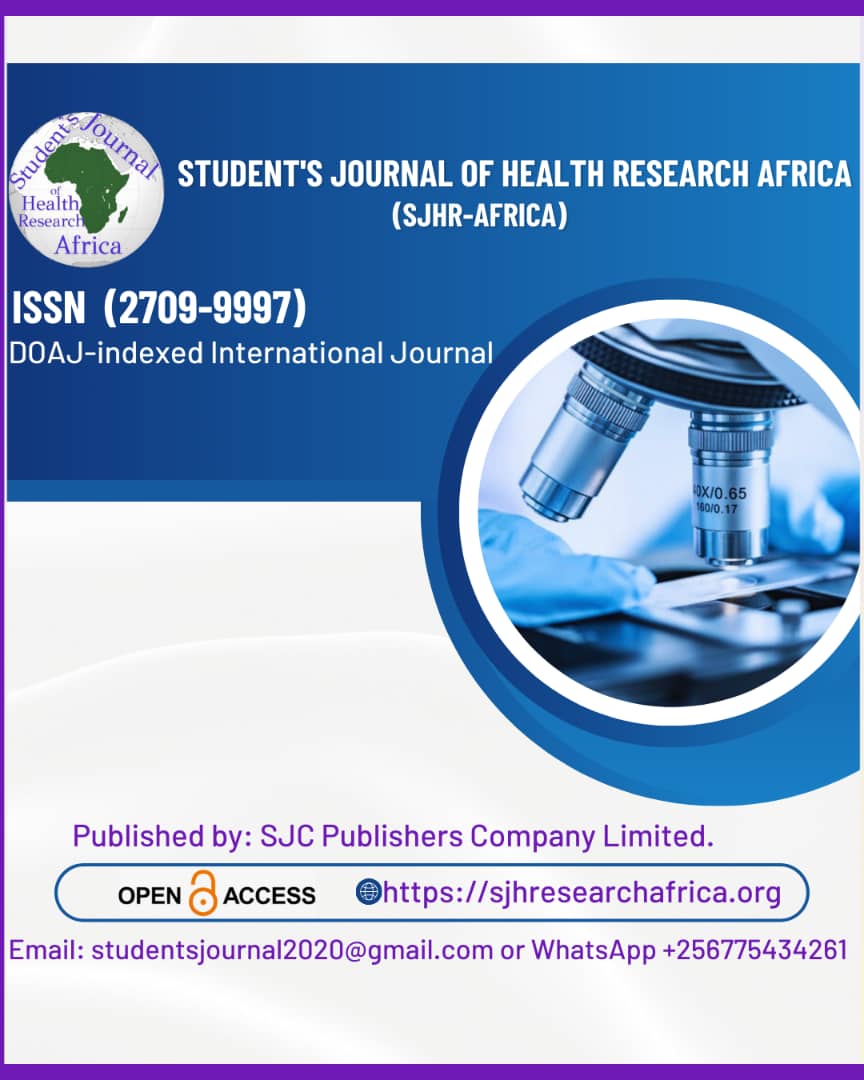A prospective observational study on urethral catheter-associated complications among general surgical inpatients.
DOI:
https://doi.org/10.51168/sjhrafrica.v6i9.2084Keywords:
urethral catheterization, catheter-associated urinary tract infection, postoperative complications, general surgery, risk factorsAbstract
Background:
Urethral catheterization is frequently employed in general surgical inpatients for perioperative and critical care management. However, its use is associated with a spectrum of complications, which may impact patient outcomes and prolong hospitalization.
Objectives:
To determine the prevalence, spectrum, and risk factors of urethral catheter-associated complications among general surgical inpatients.
Methods:
This prospective observational study was conducted on 100 consecutive general surgical inpatients who required urethral catheterization during hospitalization. Detailed demographic, clinical, and peri-catheterization parameters were recorded. All patients were followed for 30 days to identify catheter-related complications, including catheter-associated urinary tract infection (CAUTI), urethral trauma, blockage, and accidental dislodgement. Potential risk factors were analyzed using the chi-square test and logistic regression to determine statistical significance.
Results:
The mean age was 54.2 ± 15.6 years, with 62% males. Perioperative urinary monitoring was the commonest indication for catheterization (58%). The mean catheterization duration was 6.4 ± 2.8 days. Overall, 33% of patients developed at least one complication. CAUTI occurred in 14%, urethral trauma in 8%, blockage in 6%, and dislodgement in 5%. Complication rates were significantly higher in patients catheterized for >7 days (28.1% vs. 7.4%, p = 0.010), with diabetes mellitus (25.0% vs. 9.7%, p = 0.040), and with breach in aseptic technique (50.0% vs. 11.7%, p = 0.030). All complications resolved with appropriate management.
Conclusions:
One-third of general surgical inpatients with urethral catheters experience complications, most frequently CAUTI. Prolonged catheterization, diabetes, and aseptic breaches significantly increase risk.
Recommendations:
Limiting catheter duration, ensuring strict asepsis, and close monitoring of high-risk patients are essential to reduce morbidity associated with urethral catheterization.
References
Tiwari MM, Charlton ME, Anderson JR, Hermsen ED, Rupp ME. Inappropriate use of urinary catheters: a prospective observational study. Am J Infect Control. 2012 Feb;40(1):51-4. doi: 10.1016/j.ajic.2011.03.032. Epub 2011 Jul 30. PMID: 21802780. https://doi.org/10.1016/j.ajic.2011.03.032
Werneburg GT. Catheter-Associated Urinary Tract Infections: Current Challenges and Future Prospects. Res Rep Urol. 2022 Apr 4;14:109-133. Doi: 10.2147/RRU.S273663. PMID: 35402319; PMCID: PMC8992741. https://doi.org/10.2147/RRU.S273663
Hendren S, Ameling J, Rocker C, Sulich C, Greene MT, Meddings J. Validation of measures for perioperative urinary catheter use, urinary retention, and urinary catheter-related trauma in surgical patients. Am J Surg. 2024 Feb;228:199-205. Doi: 10.1016/j.amjsurg.2023.09.027. Epub 2023 Sep 20. PMID: 37798151; PMCID: PMC10922583. https://doi.org/10.1016/j.amjsurg.2023.09.027
Bacsu C, Van Zyl S, Rourke KF. A prospective analysis of consultation for difficult urinary catheter insertion at tertiary care centres in Northern Alberta. Can Urol Assoc J. 2013 Sep-Oct;7(9-10):343-7. doi: 10.5489/cuaj.574. PMID: 24319514; PMCID: PMC3854473. https://doi.org/10.5489/cuaj.574
Katayama K, Meddings J, Saint S, Fowler KE, Ratz D, Tagashira Y, et al. Prevalence and appropriateness of indwelling urinary catheters in Japanese hospital wards: a multicenter point prevalence study. BMC Infect Dis. 2022 Feb 21;22(1):175. doi: 10.1186/s12879-022-07162-3. PMID: 35189844; PMCID: PMC8862324. https://doi.org/10.1186/s12879-022-07162-3
Brockway P, Hill DM, Moll V, Stanton K, Malbrain MLNG, Velamuri SR. A Retrospective, Observational Study of Catheter-Associated Urinary Tract Infection Events Post-Implementation of a Novel Urinary Catheter System with Active Drain Line Clearance and Automated Intra-Abdominal Pressure Monitoring. Life (Basel). 2022 Nov 22;12(12):1950. doi: 10.3390/life12121950. PMID: 36556315; PMCID: PMC9782014. https://doi.org/10.3390/life12121950
Mitobe Y, Yoshioka T, Baba Y, Yamaguchi Y, Nakagawa K, Itou T, et al. Predictors of Catheter-Related Bladder Discomfort After Surgery: A Literature Review. J Clin Med Res. 2023 Apr;15(4):208-215. doi: 10.14740/jocmr4873. Epub 2023 Apr 28. PMID: 37187710; PMCID: PMC10181350. https://doi.org/10.14740/jocmr4873
Saint S, Krein SL, Fowler KE, Colozzi J, Ratz D, Lescinskas E, et al. Condom Catheters versus Indwelling Urethral Catheters in Men: A Prospective, Observational Study. J Hosp Med. 2019 Mar 20;14:E1-E4. doi: 10.12788/jhm.3180. Epub ahead of print. PMID: 30897057; PMCID: PMC7839072. https://doi.org/10.12788/jhm.3180
Youssef N, Shepherd A, Best C, Hagen S, Mackay W, Waddell D, et al. The Quality of Life of Patients Living with a Urinary Catheter and Its Associated Factors: A Cross-Sectional Study in Egypt. Healthcare (Basel). 2023 Aug 11;11(16):2266. doi: 10.3390/healthcare11162266. PMID: 37628463; PMCID: PMC10454127. https://doi.org/10.3390/healthcare11162266
Young J, Geraci T, Milman S, Maslow A, Jones RN, Ng T. Risk factors for reinsertion of urinary catheter after early removal in thoracic surgical patients. J Thorac Cardiovasc Surg. 2018 Jul;156(1):430-435. Doi: 10.1016/j.jtcvs.2018.02.076. Epub 2018 Mar 8. PMID: 29609886. https://doi.org/10.1016/j.jtcvs.2018.02.076
Hariati H, Suza DE, Tarigan R. Risk Factors Analysis for Catheter-Associated Urinary Tract Infection in Medan, Indonesia. Open Access Maced J Med Sci. 2019 Sep 12;7(19):3189-3194. doi: 10.3889/oamjms.2019.798. PMID: 31949514; PMCID: PMC6953942. https://doi.org/10.3889/oamjms.2019.798
Huang A, Hong W, Zhao B, Lin J, Xi R, Wang Y. Knowledge, attitudes and practices concerning catheter-associated urinary tract infection amongst healthcare workers: a mixed methods systematic review. Nurs Open. 2023 Mar;10(3):1281-1304. doi: 10.1002/nop2.1384. Epub 2022 Dec 15. PMID: 36519497; PMCID: PMC9912418. https://doi.org/10.1002/nop2.1384
Downloads
Published
How to Cite
Issue
Section
License
Copyright (c) 2025 Dr . Navyadeep Kanukurthi , Dr . Chandra Prakash Baindla, Dr. Yerra Sudhakar

This work is licensed under a Creative Commons Attribution-NonCommercial-NoDerivatives 4.0 International License.





















